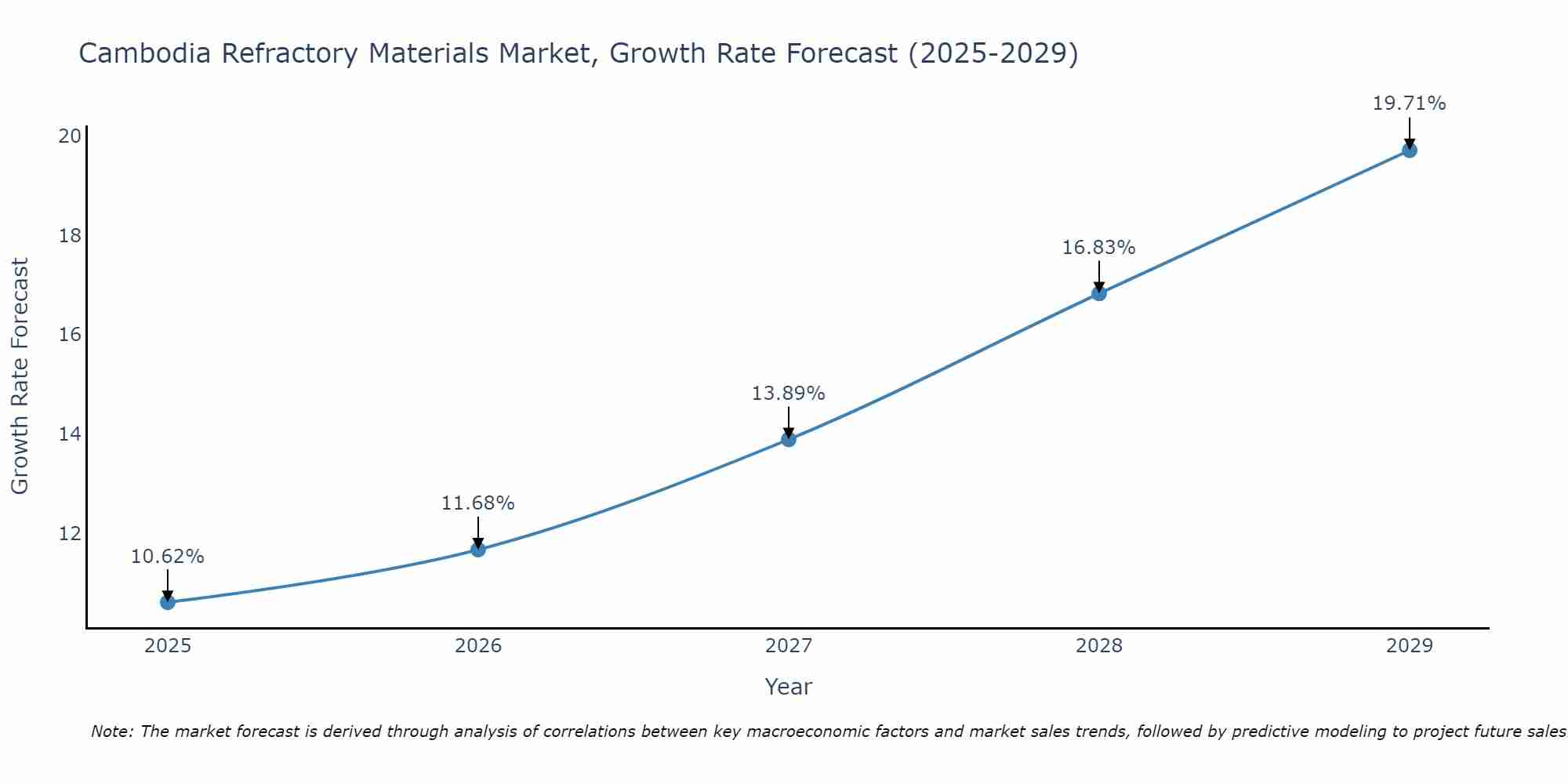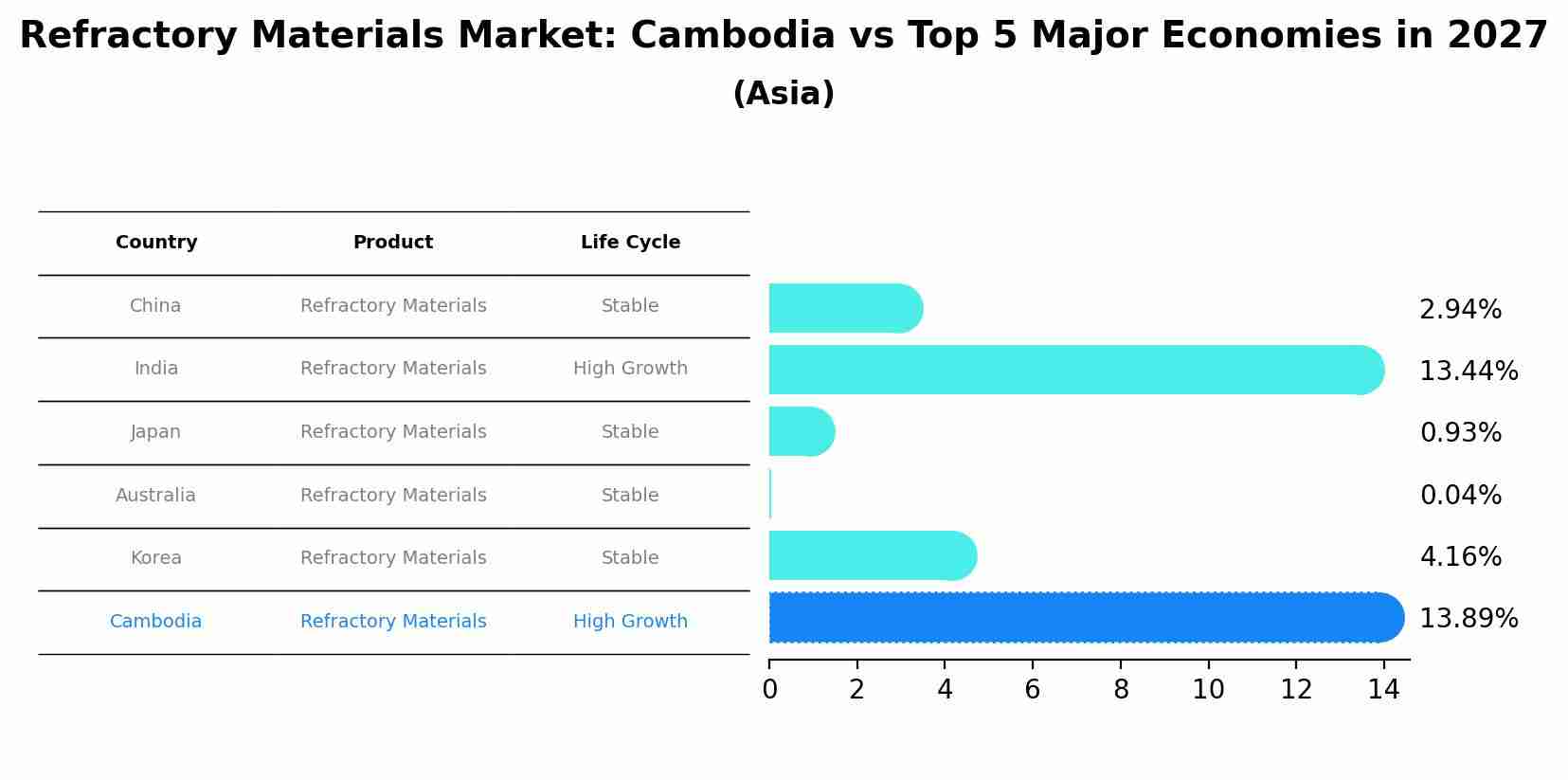Cambodia Refractory Materials Market (2025-2031) | Growth, Forecast, Companies, Revenue, Outlook, Size, Value, Analysis, Share, Trends & Industry
| Product Code: ETC033653 | Publication Date: Oct 2020 | Updated Date: Jun 2025 | Product Type: Report | |
| Publisher: 6Wresearch | Author: Shubham Padhi | No. of Pages: 70 | No. of Figures: 35 | No. of Tables: 5 |
Cambodia Refractory Materials Market Size Growth Rate
The Cambodia Refractory Materials Market is poised for steady growth rate improvements from 2025 to 2029. The growth rate starts at 10.62% in 2025 and reaches 19.71% by 2029.

Refractory Materials Market: Cambodia vs Top 5 Major Economies in 2027 (Asia)
Cambodia's Refractory Materials market is anticipated to experience a high growth rate of 13.89% by 2027, reflecting trends observed in the largest economy China, followed by India, Japan, Australia and South Korea.

Cambodia Refractory Materials Market Overview
The Cambodia refractory materials market is experiencing steady growth driven by increasing industrial activities in sectors such as steel, cement, and glass manufacturing. The demand for refractory materials in Cambodia is primarily fueled by the construction industry`s growth, leading to the development of infrastructure projects. The market offers a range of refractory products, including bricks, monolithic refractories, and ceramic fibers, to cater to various high-temperature applications. Key players in the Cambodia refractory materials market focus on product innovation, quality, and sustainability to gain a competitive edge. With ongoing industrialization and infrastructure development projects in the country, the Cambodia refractory materials market is poised for further expansion in the coming years.
Cambodia Refractory Materials Market Trends
The Cambodia refractory materials market is currently experiencing growth driven by increasing industrialization and infrastructure development in the country. There is a rising demand for refractory materials in sectors such as steel, cement, and glass manufacturing due to the expansion of these industries. Additionally, the construction sector in Cambodia is booming, leading to a higher requirement for refractory materials in the production of bricks, tiles, and other building materials. Sustainability and cost-effectiveness are emerging as key trends in the market, with manufacturers focusing on developing eco-friendly and energy-efficient refractory products. The market is also witnessing a shift towards advanced materials with superior heat resistance and durability to meet the growing needs of various industries in Cambodia.
Cambodia Refractory Materials Market Challenges
In the Cambodia Refractory Materials Market, some challenges include limited awareness and understanding of the importance of refractory materials in various industries, leading to lower demand. Additionally, the industry faces competition from cheaper imported materials, affecting the market share of local suppliers. Infrastructure limitations and logistical challenges can also hinder the distribution and supply chain efficiency of refractory materials within the country. Moreover, the lack of skilled labor and technical expertise in the installation and maintenance of refractory materials pose challenges for companies operating in the market. Overall, addressing these challenges through education, improved infrastructure, and skills development could help boost the growth and competitiveness of the Cambodia Refractory Materials Market.
Cambodia Refractory Materials Market Investment Opportunities
The Cambodia refractory materials market presents attractive investment opportunities due to the country`s growing industrial sector, particularly in construction, steel, and manufacturing industries. With increasing demand for high-quality refractory materials to withstand high temperatures and chemical corrosion in industrial processes, there is a need for reliable suppliers in the market. Investing in the production or distribution of refractory materials could be lucrative, given the potential for long-term growth and stability in Cambodia`s industrial landscape. Additionally, as the country continues to attract foreign investment and expand its industrial base, there is a growing need for specialized refractory materials that meet international standards, providing opportunities for companies to differentiate themselves and capture market share in this niche segment.
Cambodia Refractory Materials Market Government Policy
The Cambodian government has implemented policies to promote the growth of the refractory materials market in the country. These include offering tax incentives and subsidies to manufacturers, streamlining the regulatory process for obtaining permits and licenses, and supporting research and development initiatives in the industry. Additionally, the government has emphasized the importance of promoting sustainable practices and environmental protection in the production of refractory materials. By creating a favorable business environment and encouraging innovation, the government aims to attract investment, stimulate domestic production, and enhance the competitiveness of the Cambodia refractory materials market on a global scale.
Cambodia Refractory Materials Market Future Outlook
The Cambodia refractory materials market is poised for steady growth in the coming years due to increasing industrialization and infrastructure development in the country. The growing demand for refractory materials in sectors such as steel, cement, and glass manufacturing is expected to drive market expansion. Additionally, the government`s focus on attracting foreign investment and promoting domestic industries is likely to further boost the demand for refractory materials. With a rising emphasis on sustainable development and energy efficiency, there is also a shift towards using advanced and high-quality refractory materials in various industrial processes. Overall, the Cambodia refractory materials market is projected to experience positive growth opportunities, creating a favorable environment for both domestic manufacturers and international suppliers.
Key Highlights of the Report:
- Cambodia Refractory Materials Market Outlook
- Market Size of Cambodia Refractory Materials Market, 2024
- Forecast of Cambodia Refractory Materials Market, 2026
- Historical Data and Forecast of Cambodia Refractory Materials Revenues & Volume for the Period 2021 - 2031
- Cambodia Refractory Materials Market Trend Evolution
- Cambodia Refractory Materials Market Drivers and Challenges
- Cambodia Refractory Materials Price Trends
- Cambodia Refractory Materials Porter's Five Forces
- Cambodia Refractory Materials Industry Life Cycle
- Historical Data and Forecast of Cambodia Refractory Materials Market Revenues & Volume By Type for the Period 2021 - 2031
- Historical Data and Forecast of Cambodia Refractory Materials Market Revenues & Volume By Brick for the Period 2021 - 2031
- Historical Data and Forecast of Cambodia Refractory Materials Market Revenues & Volume By Monolithic for the Period 2021 - 2031
- Historical Data and Forecast of Cambodia Refractory Materials Market Revenues & Volume By Applications for the Period 2021 - 2031
- Historical Data and Forecast of Cambodia Refractory Materials Market Revenues & Volume By Clay Refractories for the Period 2021 - 2031
- Historical Data and Forecast of Cambodia Refractory Materials Market Revenues & Volume By Non-clay Refractories for the Period 2021 - 2031
- Cambodia Refractory Materials Import Export Trade Statistics
- Market Opportunity Assessment By Type
- Market Opportunity Assessment By Applications
- Cambodia Refractory Materials Top Companies Market Share
- Cambodia Refractory Materials Competitive Benchmarking By Technical and Operational Parameters
- Cambodia Refractory Materials Company Profiles
- Cambodia Refractory Materials Key Strategic Recommendations
Frequently Asked Questions About the Market Study (FAQs):
1 Executive Summary |
2 Introduction |
2.1 Key Highlights of the Report |
2.2 Report Description |
2.3 Market Scope & Segmentation |
2.4 Research Methodology |
2.5 Assumptions |
3 Cambodia Refractory Materials Market Overview |
3.1 Cambodia Country Macro Economic Indicators |
3.2 Cambodia Refractory Materials Market Revenues & Volume, 2019 & 2026F |
3.3 Cambodia Refractory Materials Market - Industry Life Cycle |
3.4 Cambodia Refractory Materials Market - Porter's Five Forces |
3.5 Cambodia Refractory Materials Market Revenues & Volume Share, By Type, 2021 & 2031F |
3.6 Cambodia Refractory Materials Market Revenues & Volume Share, By Applications, 2019 & 2026F |
4 Cambodia Refractory Materials Market Dynamics |
4.1 Impact Analysis |
4.2 Market Drivers |
4.3 Market Restraints |
5 Cambodia Refractory Materials Market Trends |
6 Cambodia Refractory Materials Market, By Types |
6.1 Cambodia Refractory Materials Market, By Type |
6.1.1 Overview and Analysis |
6.1.2 Cambodia Refractory Materials Market Revenues & Volume, By Type, 2016 - 2026F |
6.1.3 Cambodia Refractory Materials Market Revenues & Volume, By Brick, 2016 - 2026F |
6.1.4 Cambodia Refractory Materials Market Revenues & Volume, By Monolithic, 2016 - 2026F |
6.2 Cambodia Refractory Materials Market, By Applications |
6.2.1 Overview and Analysis |
6.2.2 Cambodia Refractory Materials Market Revenues & Volume, By Clay Refractories, 2016 - 2026F |
6.2.3 Cambodia Refractory Materials Market Revenues & Volume, By Non-clay Refractories, 2016 - 2026F |
7 Cambodia Refractory Materials Market Import-Export Trade Statistics |
7.1 Cambodia Refractory Materials Market Export to Major Countries |
7.2 Cambodia Refractory Materials Market Imports from Major Countries |
8 Cambodia Refractory Materials Market Key Performance Indicators |
9 Cambodia Refractory Materials Market - Opportunity Assessment |
9.1 Cambodia Refractory Materials Market Opportunity Assessment, By Type, 2019 & 2026F |
9.2 Cambodia Refractory Materials Market Opportunity Assessment, By Applications, 2019 & 2026F |
10 Cambodia Refractory Materials Market - Competitive Landscape |
10.1 Cambodia Refractory Materials Market Revenue Share, By Companies, 2024 |
10.2 Cambodia Refractory Materials Market Competitive Benchmarking, By Operating and Technical Parameters |
11 Company Profiles |
12 Recommendations |
13 Disclaimer |
- Single User License$ 1,995
- Department License$ 2,400
- Site License$ 3,120
- Global License$ 3,795
Search
Related Reports
- ASEAN Bearings Market (2025-2031) | Strategy, Consumer Insights, Analysis, Investment Trends, Opportunities, Growth, Size, Share, Industry, Revenue, Segments, Value, Segmentation, Supply, Forecast, Restraints, Outlook, Competition, Drivers, Trends, Demand, Pricing Analysis, Competitive, Strategic Insights, Companies, Challenges
- Europe Flooring Market (2025-2031) | Outlook, Share, Industry, Trends, Forecast, Companies, Revenue, Size, Analysis, Growth & Value
- Saudi Arabia Manlift Market (2025-2031) | Outlook, Size, Growth, Trends, Companies, Industry, Revenue, Value, Share, Forecast & Analysis
- Uganda Excavator, Crane, and Wheel Loaders Market (2025-2031) | Strategy, Consumer Insights, Analysis, Investment Trends, Opportunities, Growth, Size, Share, Industry, Revenue, Segments, Value, Segmentation, Supply, Forecast, Restraints, Outlook, Competition, Drivers, Trends, Demand, Pricing Analysis, Competitive, Strategic Insights, Companies, Challenges
- Rwanda Excavator, Crane, and Wheel Loaders Market (2025-2031) | Strategy, Consumer Insights, Analysis, Investment Trends, Opportunities, Growth, Size, Share, Industry, Revenue, Segments, Value, Segmentation, Supply, Forecast, Restraints, Outlook, Competition, Drivers, Trends, Demand, Pricing Analysis, Competitive, Strategic Insights, Companies, Challenges
- Kenya Excavator, Crane, and Wheel Loaders Market (2025-2031) | Strategy, Consumer Insights, Analysis, Investment Trends, Opportunities, Growth, Size, Share, Industry, Revenue, Segments, Value, Segmentation, Supply, Forecast, Restraints, Outlook, Competition, Drivers, Trends, Demand, Pricing Analysis, Competitive, Strategic Insights, Companies, Challenges
- Angola Excavator, Crane, and Wheel Loaders Market (2025-2031) | Strategy, Consumer Insights, Analysis, Investment Trends, Opportunities, Growth, Size, Share, Industry, Revenue, Segments, Value, Segmentation, Supply, Forecast, Restraints, Outlook, Competition, Drivers, Trends, Demand, Pricing Analysis, Competitive, Strategic Insights, Companies, Challenges
- Israel Intelligent Transport System Market (2025-2031) | Strategy, Consumer Insights, Analysis, Investment Trends, Opportunities, Growth, Size, Share, Industry, Revenue, Segments, Value, Segmentation, Supply, Forecast, Restraints, Outlook, Competition, Drivers, Trends, Demand, Pricing Analysis, Competitive, Strategic Insights, Companies, Challenges
- Uganda Precast and Aggregate Market (2025-2031) | Strategy, Consumer Insights, Analysis, Investment Trends, Opportunities, Growth, Size, Share, Industry, Revenue, Segments, Value, Segmentation, Supply, Forecast, Restraints, Outlook, Competition, Drivers, Trends, Demand, Pricing Analysis, Competitive, Strategic Insights, Companies, Challenges
- Australia IT Asset Disposal Market (2025-2031) | Strategy, Consumer Insights, Analysis, Investment Trends, Opportunities, Growth, Size, Share, Industry, Revenue, Segments, Value, Segmentation, Supply, Forecast, Restraints, Outlook, Competition, Drivers, Trends, Demand, Pricing Analysis, Competitive, Strategic Insights, Companies, Challenges
Industry Events and Analyst Meet
Our Clients
Whitepaper
- Middle East & Africa Commercial Security Market Click here to view more.
- Middle East & Africa Fire Safety Systems & Equipment Market Click here to view more.
- GCC Drone Market Click here to view more.
- Middle East Lighting Fixture Market Click here to view more.
- GCC Physical & Perimeter Security Market Click here to view more.
6WResearch In News
- Doha a strategic location for EV manufacturing hub: IPA Qatar
- Demand for luxury TVs surging in the GCC, says Samsung
- Empowering Growth: The Thriving Journey of Bangladesh’s Cable Industry
- Demand for luxury TVs surging in the GCC, says Samsung
- Video call with a traditional healer? Once unthinkable, it’s now common in South Africa
- Intelligent Buildings To Smooth GCC’s Path To Net Zero













